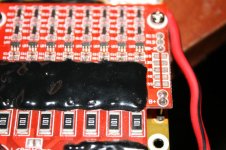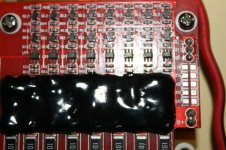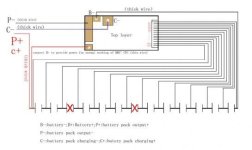Glenn_M
10 W
I have a 48V pack obtained with a ebike bought second hand. Not much is known about the pack.
I believe the KIT to be a Golden or Conhismoter kit - 48V 1000W.
Was working well then not ridden much over winter. Put in on the charger to top up the batts prior to riding again and found that it would not charge past 36V.
Checked the charger - outputting 60V
Checked BMS - 60V going through BMS to battery.
Disconnected BMS and charged batt directly - still no futher than 36V
Its a 15s pack, so using the same method as AW in his Volgood thread, here are the voltages at the balance wires:
1s- 3.6V
2s- 0
3s- 0
4s- 0
5s- 3.36
6s- 3.35
7s- 3.35
8s- 0
9s- 0
10s- 3.35
11s- 3.21
12s- 3.35
13s- 3.35
14s- 3.35
15s- 3.35
I am hoping for an easily repaired broken connection between the strings of batts.
Surgery to come
Glenn
I believe the KIT to be a Golden or Conhismoter kit - 48V 1000W.
Was working well then not ridden much over winter. Put in on the charger to top up the batts prior to riding again and found that it would not charge past 36V.
Checked the charger - outputting 60V
Checked BMS - 60V going through BMS to battery.
Disconnected BMS and charged batt directly - still no futher than 36V
Its a 15s pack, so using the same method as AW in his Volgood thread, here are the voltages at the balance wires:
1s- 3.6V
2s- 0
3s- 0
4s- 0
5s- 3.36
6s- 3.35
7s- 3.35
8s- 0
9s- 0
10s- 3.35
11s- 3.21
12s- 3.35
13s- 3.35
14s- 3.35
15s- 3.35
I am hoping for an easily repaired broken connection between the strings of batts.
Surgery to come
Glenn





